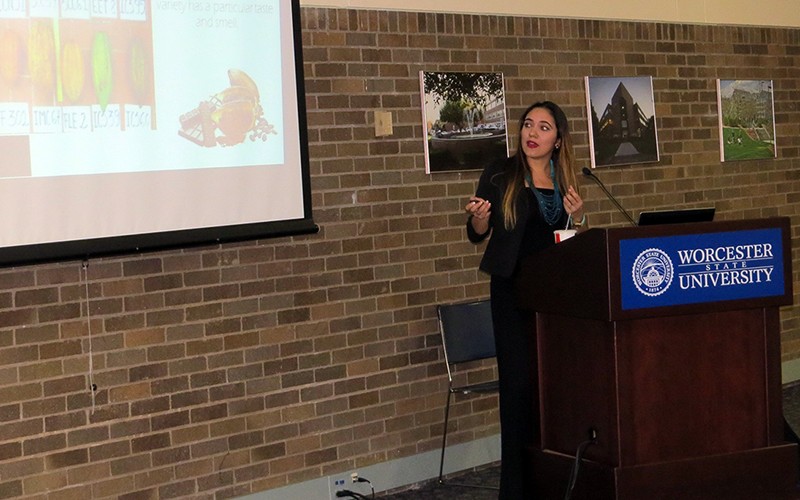What is chocolate to you? A sweet treat? A mood booster? A perfect partner for peanut butter?
In a recent talk in the Blue Lounge titled “Good Bugs, Bad Bugs, and Chocolate,” Deicy Carolina Muñoz-Agudelo, a student in Worcester State University’s Intensive English Language Institute, broke down some chocolate myths. As a native Colombian, agricultural engineer, and agronomist, Muñoz-Agudelo finds her passion uncovering the complexities of one of the top cocoa producers in the world. Colombia, where she is a professor of agriculture and project management, has been battling to keep this “miracle of nature” alive.
No Cocoa, No Chocolate
Where does chocolate even come from? Many think of it as something artificial, says Muñoz-Agudelo.
“Chocolate comes from a tree, so chocolate is salad, you can say,” Muñoz-Agudelo jokes. Chocolate comes from cocoa, which is in fact a seeded fruit that is surrounded by a delicious creamy substance. Factors such as ripeness, color, texture, and fermentation determine the quality of the end product we see—the chocolate bar.
Colombian soil has good genetics, says Muñoz-Agudelo, and therefore, Colombia has been recognized as one of the few places that produce the highest quality cocoa.
There is an extremely diverse variety of cocoa in Colombia, too. This allows farmers to produce almost 80 percent of all cocoa in conjunction with neighboring equatorial countries. Each type allows for different flavors and textures, says Muñoz-Agudelo.
But the abundance of such diverse cocoa plants is unable to survive without biodiversity in its environment. This means a plethora of plants, wildlife, and—most importantly—bugs. Having these factors in place allows for better soil and the preservation of water, says Muñoz-Agudelo.
We think bugs are bad—pests even—but “nature doesn’t have this kind of classification,” she says. Bugs in any ecosystem represent almost 95 percent of living species and have their own equilibrium.
Importance of Good Bugs
Farmers all over the world use pesticides to get rid of the bugs eating their crops. In Colombia, specifically, potential production of cocoa plants could be 2 million, but is instead at 150,000, because of the use of pesticides.
It cannot be ignored that the population of bad bugs is higher than the population of good bugs, says Muñoz-Agudelo, but using pesticides does not help because they get rid of all bugs. Consequently, the good bugs are being blocked from doing their job.
Insects such as pollinators, aphids, and caterpillars “give us so much, but we have turned them into plagues,” says Muñoz-Agudelo. Though these bugs may hurt some crops in other parts of the world, they do not touch the cocoa plant. Instead, they consume the bad bugs and fertilize the cocoa. In fact, the mosquito is vital to the pollination of cocoa flowers.
“It’s a duality,” says Muñoz-Agudelo, and pesticides block the ability for the natural balance to occur.
An Organic Solution
Cocoa is a perennial crop, so it doesn’t deplete the soil. This furthers the ability for biodiversity to be effective because it allows for many plant species to call this given ecosystem home, says Muñoz-Agudelo. Moreover, a variety of plants mean a variety of bugs.
Going organic is important, “even mandatory,” says Muñoz-Agudelo. This solution may seem obvious to us, but organic farming is new and rare in Colombia. The Colombian native and bug advocate states that she will continue to dig deeper until an organic solution is found.
Hands-On Learning
Muñoz-Agudelo talk was sponsored by IELI and supported by the Biology and Earth Environment, and Physics Departments. She enrolled in the IELI program to improve her ability to communicate in English.
In addition to sharing her scientific expertise and enthusiasm for saving Colombia’s cocoa crop, Muñoz-Agudelo’s presentation was an opportunity for her to practice speaking English in front of an audience.
Kate Tattan ’16 is an English major.
Next Story From Academic Innovation

Theme Semester Challenges the Idea that Seeing Is Believing
When Caitlyn Jenner was introduced to the world via a photo spread in Vanity Fair last year, some could not believe what they were seeing. The idea that sometimes seeing helps people believe, and an exploration of what it means to “see,” are just two ways this year’s Theme Semester, “Seeing /Believing: Evidence, Perception, and Interpretation,” will challenge the Worcester State . . .

